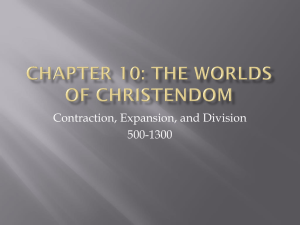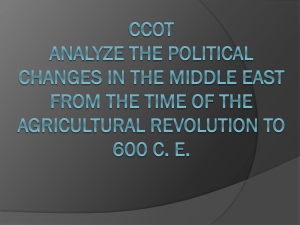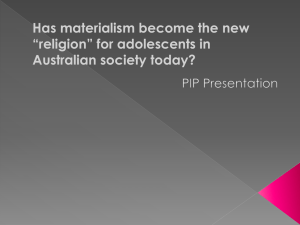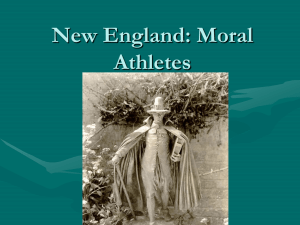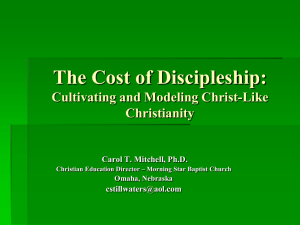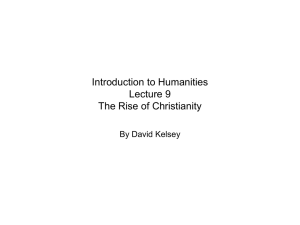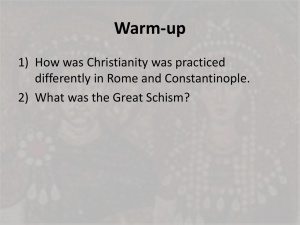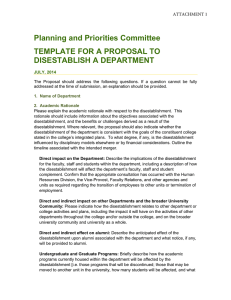*Moralistic Therapeutic Deism* Christian Smith and the Religion of
advertisement
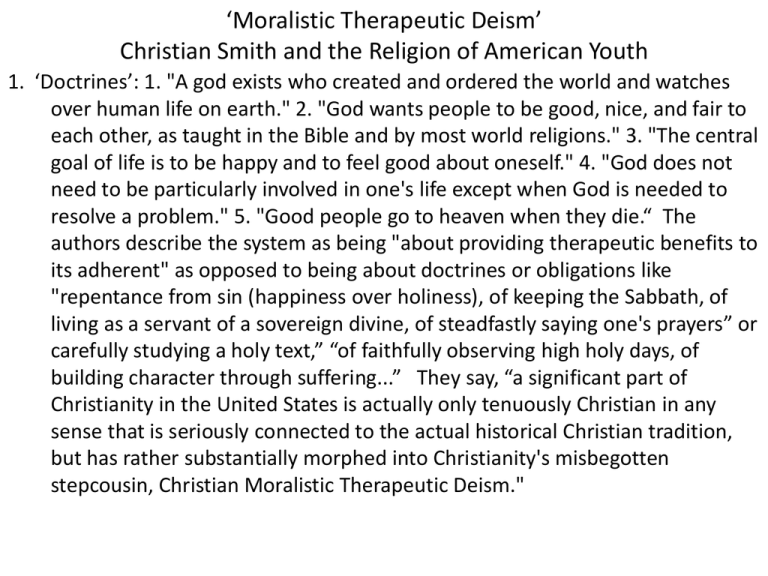
‘Moralistic Therapeutic Deism’ Christian Smith and the Religion of American Youth 1. ‘Doctrines’: 1. "A god exists who created and ordered the world and watches over human life on earth." 2. "God wants people to be good, nice, and fair to each other, as taught in the Bible and by most world religions." 3. "The central goal of life is to be happy and to feel good about oneself." 4. "God does not need to be particularly involved in one's life except when God is needed to resolve a problem." 5. "Good people go to heaven when they die.“ The authors describe the system as being "about providing therapeutic benefits to its adherent" as opposed to being about doctrines or obligations like "repentance from sin (happiness over holiness), of keeping the Sabbath, of living as a servant of a sovereign divine, of steadfastly saying one's prayers” or carefully studying a holy text,” “of faithfully observing high holy days, of building character through suffering...” They say, “a significant part of Christianity in the United States is actually only tenuously Christian in any sense that is seriously connected to the actual historical Christian tradition, but has rather substantially morphed into Christianity's misbegotten stepcousin, Christian Moralistic Therapeutic Deism." 2. Sources – their churches, either explicitly in teaching (moralism over doctrine - Veggie Tales motto; God over love rather than wrath/judgment; more talk of God than Christ; little ‘expository’ preaching/teaching) or implicitly in practice (church is designed to satisfy the ‘felt needs’ and demands of contemporary people according to what we know pleases them in the culture rather than to satisfy or please God according to what we know pleases/satisfies Him in Scripture). Souls in Transition (Emerging Adults) 1. Landscape of 18-29s: committed traditionalist (15 percent), selective adherents (30 percent; loosely connected and very selective in the tradition they were raised in), spiritually open (15 percent), religiously indifferent (25 percent), religiously disconnected (5 percent), and irreligious (10 percent). 2. Losing their religion? Sort of -- Just as religious as the previous generation in belief, but not in practice (particularly church attendance/membership). Part of an overall movement away from commitment in relationships and to institutions. Summary of Smith’s findings: Emerging adults live in an emotional world where self is still pretty much the focus, where right and wrong are just common sense and, for most, morality that involves the notion that one's choices should not hurt anyone. Additionally, it is a social and emotional world where everyone is different (and that's just fine) and personal choices are simply that: personal choices. Religious choices are seen in the same realm, personal, not proscriptive. And settling down is for later, perhaps much later in life. 3. Causes? Parents, devotional life as a teen, church-politics association, church partitioning by ‘peers’ (no mentoring; instead, churches stress peers over parents/adults), churches cater to young-married families; message is me-and-Jesus (no ecclesiology) II. Brief Church and State History Leading to American Birth “The American founders revolutionized the Western tradition of religious liberty. But they also remained within this Western tradition, dependent on its enduring and evolving postulates about God and humanity, authority and liberty, church and state.” A. First Millennium 1. Christians came out of periods of extensive and intensive persecution by the Romans. They were noncomformist (refused to worship pagan gods or Ceasar) and agitators (sought to transform pagan society with Christian morality; charity, burials, infants, social customs). Emperor Julian “These impious Galileans not only feed their own poor, but ours also; welcoming them into their agapae, they attract them, as children are attracted, with cakes. Whilst the pagan priests neglect the poor, the hated Galileans devote themselves to works of charity, and by a display of false compassion have established and given effect to their pernicious errors. See their love-feasts, and their tables spread for the indigent. Such practice is common among them, and causes a contempt for our gods.” 2. Persecution ended when Emperor Constantine converted to Christianity, signed the Edict of Milan (311) tolerating all religious beliefs though privileging Christianity some. 3. 4. B. 1. 2. Future emperors, however, began to pursue a policy of preference and control over Trinitarian Christianity (supreme over church and state). Augustine, addressing critican pagans and disillusioned Christians, put these realities together in City of God (413-427), where he argued that Christians are primarily citizens of a different city (not city of man), but it would be better for all if the rulers of the city of man favored Christianity (though institutionally separate from, if not under, church authority). BUT, few emperors could resist the urge to consolidate and control the spheres. He further refutes Roman superiority as fulfillment of history (focal point). Rather, no state (Christian or otherwise) can be identified as God’s Kingdom on earth; heavenly kingdom is always future. Papal Revolution – changed all that after 1050 when a series of Popes moved towards ecclesiastical separation from and even control of civil leaders (Catholic independence). Canon Law - The papacy claimed expanded jurisdiction in law, treatment of non-Christians, church life, and political matters. Out of these papal pronouncements, we get “Canon Law” (first modern body of international law). Based on notion that Pope had “two-swords” (civil law and canon law, where canon in superior to civil). Whole systems of law developed around seven sacraments (baptism, eucharist, penance, orders, extreme unction, confirmation, and marriage). Rights – a whole body of legally recognized ‘rights’ emerged out of this tradition. These rights constrained church/state and protected the Catholic faithful (not others) from arbitrary or oppressive ecclesiastical and civil decisions. 3. This system of international law began to break down as nationstate kings asserted their own territorial authority and refused to recognize Canon Law as absolute/binding. C. Protestant Reformation (16th and 17th century); march toward religious tolerance, liberty, disestablishment, constitutional republicanism 1. Luther’s contribution – (1) territorialized the faith; establishment should be local (2) Two Kingdom Theory – Christians are members of two God ordained, legitimate, good kingdoms; The civil sphere administers law; church administers Gospel. 2. Anglicans nationalized the faith – model that was basically NOT continued by new world protestants 3. Anabaptists communalized the faith – emphasis was on the irreconcilable differences between realm of religion/church and realm of the world. 4. Calvin’s reformation congregationalized the faith; church was to be ruled by elected leaders (pastors, elders, deacons) bound to written confessions of faith D. Political Implications of PR: Reformers of both generations articulated a political philosophy based upon their reading of Scripture which denied the absolute authority of the state (or people); considered rulers and subjects as equally valuable (same as in church); placed the people and law above the king who is a ‘servant’; generally called for a federal-democratic, divided, political system of limited government to deal with sinful tyranny; called for a constitution which mirrored Biblical covenants where divine law (perhaps 10 commandments) serves as a transcendent ground of civil law (confession in church; covenant-compact in politics); acknowledged right of people to resist and depose a king who violates the terms of covenant; insisted that we do not form government based on self-interest or ideals that we ourselves determine (read p. 13 Witte). These ideas flowed from Calvinism which taught that God alone is absolutely sovereign; man is simultaneously a wicked-sinner and dignified-Image bearer (equality/freedom); gov’t of all kinds should follow Old and New Testament models (less hierarchical and more democratic); covenant theology (next slide) Note on church government – the most common forms of church government (decision making structure) among the Reformers was congregational (democratic-republic) or presbyterian (federal-republican). Clearly, many reformers came to believe that their view of how church gov’t should be structured came to influence how civil government should be structured (“Presbytery agreeth with monarchy like God with the devil”) E. Constitutional Covenantalism: The Puritans viewed a covenant as a social and divine promise: each participant in the covenant is expected to do certain things. A violation of the covenant could have the most disastrous consequences for those who had entered therein. Following biblical precedents, a covenant would also last from generation to generation. By means of these covenants, Puritans were among the first English speaking people to implement a government bound by written words in a single document. Example, Deut 1:1-17 Comparing Covenants and Contracts: • Covenants use Broad instead of Narrow language (no loopholes) • Covenants are solemn sacred promises instead of cold legal words on paper • Covenants are social/communitarian in nature instead of individual (We instead of I) • Covenants identify a collective purpose and identity; • Covenants are validated or sealed in the presence of and by an external higher authority, typically God *Think about a difference between marriage as a ‘covenant’ vs ‘contract’ and you might get the spirit of the distinction. Reformation Political Thought • • • • • Political Sovereignty rests with God people state Ground of Natural Human value/rights = Imago Deo (originates with God) Justification for Gov’t = ordained by God at least to suppress evil (original sin), promote common good including proliferation of true religion (more communitarian) Constitution = morally-informed pact between people having independent/equal status, constructing a limited gov’t based upon voluntary consent and established by promises made before God. Implications – Reformation political thought led more to federalrepublicanism, with divine law and God as supreme; elected reps from each political unit, tribe, church, state (Glorious Revolution, English Civil War). Also Federal Secular Enlightenment Political Thought • People State • NHR ground = State of Nature, mutual and unanimous consent, virtue of being human (originates with humans)* • Why gov’t? Self-interest, protect natural rights (life, liberty, property); return individuals to natural state of autonomy; more individualistic • Constitution is a legal contract among people to form gov’t for sake of self-interest, limited gov’t, and binds all (posterity and immigrants) • Implications - Enlightenment thought led more to democracy, with human law and the majority as supreme (French Revolution) *Today’s liberal theorists like Rawls attempt to ground freedom in something other than natural rights/law (too religious) and appeal only to what is rational. I. A. 1. 2. 3. 4. B. Religion and the Constitution in 18th Century America Introduction - how did America come to accept/enshrine principles of religious liberty, tolerance, disestablishment, churchstate separation? Why look beyond the Constitution to understand the role of religion in American politics? Constitution sets outer boundaries (no prescription or proscription of religion by government). The records of the constitutional congresses’ debates on the first amendment are brief/sketchy. Limited to Congress, not states (“Congress shall make no law…) Framers intended for states to interpret these clauses and appropriate them as they saw fit (Madison quote, Witte, p. 22) To understand the intended relationship generally, at the time, we must identify the principle players involved in forging the consensus behind church-state relations in the 18th century by looking at four groups: on the religion side, Puritans and Evangelicals; on the political side, Enlightenment thinkers and Classical Republicans. II. A. 1. 2. 3. The four groups American Puritans (dominant from 1630-1730) and the Christian Commonwealth – having been persecuted and/or regulated by both Catholic and especially Anglican monarchies, this group took their Calvinism to America (system of Christian theology stressing the utter sovereignty of God in all things as well as the institutional separation of church/state). Early and key group are Congregationalists. Church and State are separate distinct ‘covenantal associations’ or two seats of God’s authority. Church was about preaching, sacraments, charity. State was about enforcing law, punishing crime, instilling virtue, and order. Clergy could not hold political office; political leaders could not hold church office. BUT, though not to be confounded, they were to be “close and compact” (the community is a common project of both church and state, so some interdependence). State provide church with public properties, tax exemptions, subsidies, Sabbath Day laws. Church provided state with meetinghouses/chapels, community schools/libraries, maintenance of census rolls, marriage, death certificates; offered ‘election day sermons’ to promote civil participation. Emphasis on community and local religious conformity led to banishment of dissidents, like Quakers, Baptists, Catholics, Jews, etc. Puritans were separatists from Anglicanism, but this did not initially seem to require them to accept disestablishment or toleration at the local level. 4. Things changed, however, in 1689 (Toleration Act) as more and different kinds of Protestants from around Europe sailed over. The Act required toleration, but not full political equality of, other traditional Protestant churches. More and more, the ‘covenantal’ idea of civil society (though not church society) was viewed as more open and voluntarist by Puritans in terms of individual conscience (open to other Christian sects). Came to celebrate, rather than suppress, denominationalism in theology (idea that there are many paths to God within orthodox Protestant Christianity) and toleration of religious pluralism in civil society. Read pp. 25-26 Witte. B. Evangelicals – Product of the Great Awakening (1720-1780). 1. Great Awakening - a series of evangelists (Wesley, Edwards, Whitefield, Tennet) began to challenge the dry, rigid, religious legalism (‘conversionless Christianity’ where salvation is conferred through ritual or routine) and institutionalization, protection, of the church by the state. Wanted fuller separation, more freedom of association, and liberty of conscience (remember, these were either new or unestablished groups like Baptists, Methodists, and Presbyterians). John Leland, a Baptist fiery preach, said, “The notion of a Christian commonwealth should be exploded forever.” 2. C. Isaac Backus, Reformed Baptist theologian mid to late 18th century (p. 28) – Christianity should fear BOTH state repression and support of religion. Establishment results in a distraction from divine mandates and capture of established church. Want to promote Christianity? Deregulate it. Besides, the state and church are not working on the same projects (maintaining order vs proclaiming gospel) or using the same means (sword vs means of grace). He coined term separation of church and state. Led evangelicals in pushing for constitutional means of disestablishing religion. Enlightenment views – provided theory complementing evangelical theology on religious liberty. Locke argued that the state only exists to protect life, liberty and property (man’s ‘outward’ concerns), not to promote religion (man’s ‘inward’ concern). Laws cannot touch one’s mind, which is the object of religious activity. He did, however, argue that state laws would only ‘seldom’ conflict with Christian values and he refused to tolerate atheists altogether (can’t be trusted to keep promises or oaths). Saw disestablishment and religious liberty as solution to violent religious conflict (political instability). Summarized by Madison well (p. 31 Witte). D. Republican Views – spokespersons were Washington, Adams, Benjamin Rush, etc. If Enlightenment thinkers (like Jefferson) naturally aligned with Evangelicals, Classical Republicans naturally aligned with old Puritans. Agree with both E’s on disestablishment and liberty of conscience, BUT wanted the state/public square feature a common religious ethic (non-sectarian and not theologically specific). They stressed the utility of Christianity as a prerequisite to happy citizens, effective/efficient good government (pillar of society and necessary for its peace, prosperity, and endurance). Read p. 33. Their approach was similar to Massachusetts constitution (see p. 34-35) E. Establishment of Civil or Public Religion - Result, the Classical Republicans won out. First, it won out in the first Continental Congresses through official actions/proclamations (chaplains, schools, missionaries, prayers, Northwest Ordinance 1878). Second, won out among states by leaving alone state establishment practices (promoting even particular denominations). Third, it won out in time (we continue to favor or accommodate, in a number of official and unofficial ways, generic monotheism and Christianity in everything from money to White House Christmas. Forging the First Amendment at the Constitutional Convention I. A. B. C. The Context of Religion Clauses leading up (1774-1787) Paid chaplains to lead prayer at Cont Congress entire time. Thanksgiving day and fast-day proclamations (1775), one of four proclamations “it is the indispensable duty of all men to adore the superintending Providence of the Almighty God.” Also urged all men to “express the grateful feelings of their hearts” by “publick humiliation, fasting, and prayer” and “confess and deplore our many sins” and pray that “it may please God through the Merits of Jesus Christ, mercifully to forgive and blot them out of Remembrance,” that God would grant the “promotion and enlargement of that Kingdom, which consisteth in Righteousness, Peace, Joy, in the Holy Ghost.” Voted to fund the procurement of 20k Bibles for distribution in the States (never done due to lack of funds; later merely encouraged states to have “one or more new and correct editions of the Old and New Testament to be printed…” D. E. II. A. B. C. Writers of the Articles of Confederation refused to prohibit religious tests for public office holding Resulting sentiment captured in the Northwest Ordinance AFTER the First Amendment was written. On the one hand, in the territory no one was to be “molested” on account of his religion, but religion was to be promoted in the territory by the government. Drafting Process House version: “Congress shall make no law establishing religion, or prohibiting the free exercise thereof, nor shall the rights of conscience be infringed.” Elsewhere, a sixth amendment would say, “No person religiously scrupulous shall be compelled to bear arms in person. Senate version (three early versions defeated read p. 87-88). Senate version (#19 p. 88): Congress shall make no law establishing articles of faith or mode of worship, or prohibiting the free exercise thereof.” A conference committee (HR and S) composed of a cross-section of our four groups gave us our current/final version with no surviving debate details. III. A. B. 1. 2. 3. How are we to make sense of their unclear intentions? Two possibilities: Thinner reading – clauses set outer boundaries of appropriate congressional actions on religion (neither prescribe nor proscribe). Leaves open later discussion and perhaps legislation on religion. Based on fact that earlier drafts had more sweeping language and were rejected (Congress shall not ‘touch’ or ‘favor’ or ‘prefer’ religion). Instead, they adopted ‘respecting’ (point to) establishing religion. Thicker readings – (more reading in to the words) Congress – not binding on the states Shall make no law – no new laws, but confirming existing ones? Probably not, since new laws easily passed that did in fact touch on religion. Respecting an establishment – could refer to C not touching a state established religion (6 had them then); or could mean C cannot pass laws aimed at promoting an established religion (respecting is an umbrella term touching on doctrines; required worship, mandatory tithing, etc.); so on the first view, concern is not interfering with states; on the second, the concern would have been not to allow Congress to move in the direction of a national established church (with all attendant laws). The first reading gives Congress no guidance on national laws affecting religion; the second gives them guidance, but does not allow much beyond what was already commonplace (chaplains, religious education, etc.). Conclusion? Non-preferentialism – a mixture of these views suggesting that all the founders intended (or could agree upon) was to outlaw an established national religion, but allows for support of religion in general. Put positively, C can “touch” religion so long as it favors no particular one. This view explains the various laws touching on religion (chaplains, etc.). This view has a harder time explaining the word “respecting” however. 4. Prohibiting Free Exercise – umbrella term referring to all that is meant by free exercise; this reading would mean that it merely prevents C from prohibiting free exercise of religion (they dropped the liberty of conscience clause) 5. Religion – IMPORTANT DEFINITION; to get free exercise, it must be religious; to constitute establishment it must be a religion (or religious); what is the pale of recognized religion? Then it did not go beyond monotheism (Jews, Islam, Deism, Christianity, etc.). What about conscientious objectors? In the end, we get a new experiment, despite the lack of clarity, when it comes to church state relations. Read Madison p. 100-101.

